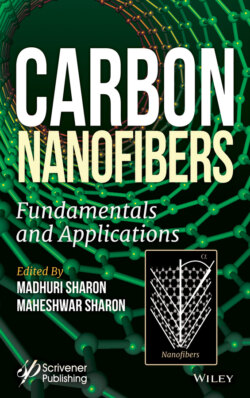Читать книгу Carbon Nanofibers - Группа авторов - Страница 81
3.5 Different Types of CNF
ОглавлениеCarbon nanofibers of various morphologies have been synthesized (Figure 3.6). Some of them are mentioned below:
Platelet-like CNF is composed of small graphene layers perpendicular to the fiber axis and the fiber must contain a non-negligible amount of hydrogen or other heteroatoms for the stabilization of the plates. The fibrils can also be coiled, as shown in Figure 3.4a,b [34]. For the growth of platelet, CNFs from propane Ni/Al2O3 catalyst have been found to be good catalyst.Figure 3.6 CNF of different morphologies: (a) Platelets, (b) Spiral platelets, (c) Fishbone hollow core, (d) Fishbone solid, (e) Ribbon, (f) Stacked cup.
Fishbone-like CNF or Herringbone CNF is where the graphene layers are inclined with respect to the fibril axis. Consequently, hydrogen is also required to stabilize the edges. Fishbone CNFs can have either a hollow core (Figure 3.4c) or a solid core (Figure 3.4d). The herringbone CNFs are synthesized over Ni/Al2O3 catalyst using methane and propane as carbon sources.
CBF Ribbons are comprised of straight, unrolled graphene layers that are parallel to the fibril axis with noncylindrical cross sections (Figure 3.4e). Transition metal Co, originated from Co(NO3)2·6H2O doped in spinning solution, serves as both template of mesopores and catalyst for graphitic structure [35].
Stacked-Cup CNF This form of CNF is a continuous layer of rolled (spiral) graphene along the fiber axis. The spiral orientation of these nanofibers yields a truncated cone arrangement along the axis with a wide internal hollow space, as shown in Figure 3.4f. SiO2 particles are used as catalysts for stacked-cup carbon nanotube formation in a spray pyrolysis chemical deposition method from ethanol where SiO2 particles are reduced to SiC following a carbon dissolution mechanism [36].
Thickened Tubular CNFs are comprised of a base structure of one of the previously mentioned catalytic nano filaments (CNF or CNT) with a variable coating of amorphous carbon produced by CVD method using Fe/Al2O3 catalyst with ethylene as a carbon precursor by CCVD.
Figure 3.7 shows CNF grown using catalytic chemical vapor deposition (CCVD) with methane as carbon source and a hydroxyapatite-supported nickel (Ni/HAp) as catalyst. The catalyst, which contained approximately 14 wt% Ni, was prepared using the incipient wetness method with an aqueous nickel nitrate solution. Three variables were evaluated to optimize the CNF growth process, including the temperature and the time of catalyst reduction as well as the reaction time, at 650 °C. Herringbone bamboo-like CNFs were grown during methane decomposition over Ni/ HAp, which was confirmed using transmission electron microscopy [37].
The diameters of the grown CNFs were determined by TEM. As shown in Figure 3.7 the CNF diameters increase as the reduction temperature increases. At 550 °C, CNFs with a diameter of 25–45 nm were grown with a predominant contribution of narrower nanofibers. At 600 °C, a wide distribution of CNF diameters in the range of 25–55 nm was observed. CNFs with a diameter of 36–55 nm were obtained when the Ni/HAp catalyst was reduced at 650 °C. The shift in the CNF diameter to larger values as the reduction temperature increases was due to an increase in the Ni crystallite size. CNFs with larger diameters were also grown by increasing the reaction temperature [38].
Figure 3.7 TEM images of CNFs with (a & b) herringbone structure without hollow core, synthesized over nickel catalyst using both methane and propane as carbon precursors respectively; (c) The platelet structure in which the graphene layers are aligned perpendicularly to the fiber axis, and (d) the thinnest among the synthesized nanocarbons, with diameters of 10–20 nm [38].
